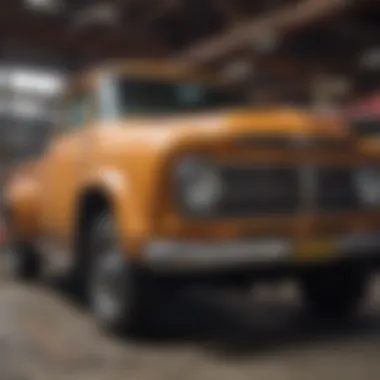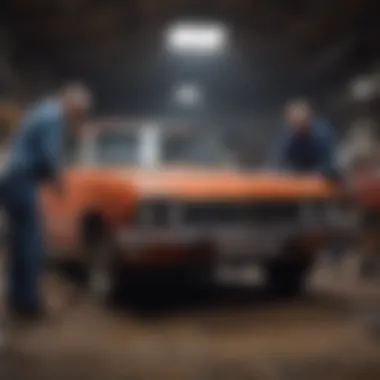Exploring the Value of Salvage Vehicles


Intro
Salvage vehicles often carry a certain mystique, don’t they? For many, they symbolize not only the thrill of restoration but also the potential for a wise financial investment. However, the world of salvage vehicles is far more complex than most realize. It’s not just about scouring auctions for a rusting Mustang that needs a bit of TLC; it's about truly understanding the market dynamics, the costs involved, and the ultimate value of these vehicles. Whether you're a first-time buyer or a seasoned collector, this article aims to peel back the layers, enriching your knowledge about salvage cars.
Investment Terminology
Key Terms and Definitions
To get a grip on the intricacies of salvage vehicles, it helps to familiarize yourself with some key terminology. Here are a few terms you might encounter:
- Salvage Title: This is a title that indicates the vehicle has been damaged, often to the extent that it's considered a total loss by insurance standards. It can be a bit of a double-edged sword, as it can signify a bargain buy but also hides potential risks.
- Rebuilt Title: When a salvage vehicle is repaired and passes a state inspection, it may receive a rebuilt title. This lets prospective buyers know that the vehicle has been restored, but they should still be cautious about knowing the extent of the repairs.
- Market Value: The likely price range that a vehicle might fetch based on its condition, historical significance, and demand in the salvage market.
- Appraisal: A formal valuation conducted by a professional who assesses the vehicle's condition and historical context to establish its worth.
Understanding these terms is crucial as they set the stage for informed decision-making.
Common Acronyms in Finance
In the sphere of investment, accumulation of knowledge often comes with a share of shorthand. Many acronyms will pop up, especially when evaluating vehicle investments. Here are few that might save you a mental jog:
- ROI – Return on Investment: This is a key measure that tells investors how much profit they stand to make relative to their investment.
- NADA – National Automobile Dealers Association: They provide guides on vehicle values that can assist in assessing the worth of salvage cars.
- VIN – Vehicle Identification Number: A unique code that gives you insight into a specific vehicle's history and specifications.
These acronyms can help streamline discussions about investments and keep you in the know.
Expert Insights
Investment Strategies Overview
When diving into the salvage vehicle market, having a solid strategy is akin to having a roadmap. Each turn can either lead you closer to a bargain or down a path you’d rather avoid. Here are some strategies to keep in mind.
- Know Your Budget: Before you even think about bidding, it's not just about the car price. Factor in restoration costs, ongoing maintenance, and potential resale expenses.
- Research Before You Buy: Do your homework regarding market trends and popular models. Some car brands hold their value better than others, making certain models more attractive as investments.
- Get a Professional Inspection: Like they say, don’t judge a book by its cover. A thorough inspection can reveal hidden issues that could drain your resources down the line.
"A well-researched purchase can save you from a costly mistake."
Tips from Financial Advisors
Expert advice can often shine a light on avenues you might have overlooked. Here are some tips from financial advisors that you might want to consider:
- Be Patient: Don’t feel pressured to make a quick purchase. The right vehicle will come along at the right time.
- Network with Other Enthusiasts: Joining local groups or online forums can provide insights and opportunities you might not find on your own. Websites like reddit.com have vibrant communities discussing salvage vehicles.
- Consider Future Value: Think ahead—what models are gaining interest? Will this vehicle be collectible in a few years?
In summary, navigating the salvaged vehicle sector is a journey laden with both pitfalls and possibilities. With the right knowledge and strategies, you can turn what might seem like a daunting process into a fruitful pursuit.
Preface to Salvage Vehicles
Understanding salvage vehicles offers a window into a unique niche of the automotive world that many overlook. For some, these vehicles are simply another discarded piece of machinery; for others, they represent opportunity and potential. Engaging deeply with salvage vehicles can help buyers not only save money but also invest wisely, whether for personal projects or resale.
Defining Salvage Vehicles
A salvage vehicle is typically one that's been damaged to the point where insurance companies deem it uneconomical to repair. The specific criteria can depend on various factors, like the cost of repairs relative to the vehicle's value. Generally, if the repair costs exceed a certain percentage of the vehicle’s worth—often around 75%—it’s classified as salvage. It can stem from various situations:
- Accidents: Collisions that significantly damage body or mechanical components.
- Natural Disasters: Damage from floods, hurricanes, or hail.
- Theft Recovery: Vehicles that were stolen and then recovered, often in a damaged state.
Salvage vehicles come with a variety of conditions and histories, making it essential for buyers to understand what they are getting into. They aren't just fixer-uppers; they may require significant work and troubleshooting to return them to peak condition. For someone interested in automotive restoration, this can be an exciting challenge.
Historical Context of Salvage Vehicles
The landscape for salvage vehicles has undergone considerable evolution over the years. In the past, a vehicle labeled as salvage was often seen as inherently undesirable, relegated to back lots or scrap yards. With shifting consumer attitudes and technological advancements in restoration techniques, perceptions have changed.
Salvage vehicles started gaining traction post-1990s when restoration shows began appearing on television. Enthusiasts learned how to breathe new life into seemingly useless cars. Alongside this, social platforms such as Facebook and forums on Reddit allowed for the exchange of ideas and experiences, fueling a community that celebrates these vehicles.
The legalities surrounding salvage titles and the regulations imposed by various states further complicate their history. Each state has its own laws regarding salvage vehicles, affecting their resale, repair, insurance, and even roadworthiness.
"For many, salvage vehicles signify the chance to unleash creativity and craftsmanship, converting wrecks into works of art."
This evolution highlights a broader cultural shift where salvage vehicles now represent not just cost savings but an opportunity for unique automotive experiences. As these vehicles find new owners, they tell tales of past journeys, promising fresh paths ahead.
Understanding Vehicle Salvage Title
Understanding vehicle salvage titles is a crucial aspect of the salvage vehicle landscape. This title marks a vehicle's history, indicating that it has been deemed a total loss by an insurance company. Knowing how to read and interpret a salvage title is imperative for anyone interested in purchasing salvage vehicles, whether it's for personal use or investment. It informs the buyer of past issues, thus providing a more complete picture of the vehicle's possible future.


The primary benefit of grasping the nuances of salvage titles lies in informed decision-making. A buyer who understands what a salvage title entails is better equipped to assess the potential risks and benefits involved. Instead of jumping head-first into what might appear to be a dream bargain, you'd be wise to ensure that the vehicle meets your needs and expectations.
What is a Salvage Title?
A salvage title is issued when a vehicle has sustained damage that costs more to repair than its market value. This can arise from accidents, floods, or other disasters, leading the insurance company to classify it as a total loss. In many jurisdictions, a vehicle cannot be legally driven until it has undergone inspection for safety and can be retitled as a rebuilt or restored vehicle.
Understanding the specific implications of a salvage title is essential for transparency in transactions. For instance, consider the scenario of someone buying a car with a salvage title. That person's knowledge about what this means—regarding repairs, legal driving stipulations, and resale value—directly impacts their satisfaction and overall experience.
Variations in State Regulations
State regulations surrounding salvage titles can differ significantly. In some places, you might find that a salvage vehicle can be re-registered with relative ease, while in others, the process could be fraught with red tape. Some states allow a vehicle to be retitled as “rebuilt” after passing an inspection, while others may impose restrictions that complicate the re-entering of the title back into regular use.
- Inspection Requirements: Different states have varying inspection protocols. Some may only require a visual inspection, while others necessitate extensive mechanical checks.
- Disclosure Laws: Certain states have laws mandating that sellers disclose the salvage title status to potential buyers. Not adhering to these rules can lead to legal consequences.
- Resale Restrictions: Some regions limit how salvage vehicles can be resold, impacting future sales opportunities for buyers.
Suffice it to say, being aware of these regulations is pivotal. The last thing anyone wants is to be caught off guard by unforeseen legal or logistical hurdles in the quest for a salvage vehicle.
"Understanding your state's regulations regarding salvage titles could save you a lot of headaches down the line. Ignorance often translates to costs, both financial and emotional."
In summary, a firm grasp of what a salvage title signifies and the varying regulatory frameworks can minimize risks and elevate the chances of a rewarding purchase. Salvage vehicle buyers are encouraged to be diligent and informed as they navigate this tricky yet potentially lucrative domain.
Factors Affecting the Value of Salvage Vehicles
Determining the value of salvage vehicles isn't just a game of numbers; it's a intricate dance involving various factors. Each element plays a role in how much someone might pay for a ride that’s seen better days. Understanding these factors helps buyers assess potential investments and avoid pitfalls. Essentially, the fundamental question revolves around why one salvage vehicle might fetch a pretty penny while another barely crusts the bottom of a bid sheet. Through a close look at market demands, damage types, vehicle models, and even geography, we can pull back the curtain on this complex valuation process.
Market Demand and Trends
The pulse of the market always beats to the rhythm of the buyer’s interest. In salvage vehicle sales, trends emerge and fall just like the tide. If a particular make or model garners favor in the enthusiast circles, prices can soar sky-high. A prime example is the spike in demand for classic cars like the Ford Mustang or the Chevrolet Camaro; even if they bear salvage titles, collectors and restorers often dive in headfirst, ready to invest.
Factors like economic conditions, social media influences, or even new regulations can shape trends. In light of today’s increase in eco-consciousness, electric salvage vehicles, such as salvaged Teslas, may become increasingly appealing. Therefore, it’s wise to keep an ear to the ground, tracking evolving consumer interests that can signify potential profitability if you choose to dip your toes in this market.
Type of Damage Sustained
It makes sense: not all damage is created equal. Vehicles can come across a myriad of issues, from frame damage to electrical faults. Each kind affects value differently. For instance, a car that suffered just minor body damage but remains mechanically sound can still be snagged at a reasonable price. In contrast, one that faces extensive structural repairs or severe water damage can send potential buyers running for the hills.
Potential investors ought to evaluate the specific type of damage closely. A meticulous inspection can pinpoint whether repairs lean towards doable or daunting. Knowing which repairs are feasible can help buyers gauge if they are walking into a reasonable project or drowning in a money pit.
Make and Model Considerations
The classic axiom ‘you get what you pay for’ resonates strongly in the salvage vehicle realm. Some makes and models naturally retain higher resale values than others, even when salvaged. Luxury brands such as Mercedes-Benz, BMW, or even high-end SUVs from Land Rover often attract more eager buyers compared to economy brands. Just the brand name alone can swing things in its favor, which is key information for investors to grasp.
Furthermore, rarity also packs a punch. Limited-edition models or those with a loyal following might draw a crowd simply because of their scarcity. So, when weighing your options, it’s important to consider not just the vehicle’s condition but its brand reputation and desirability as well.
Location and Availability
Last but not least is geography. The region where a salvage vehicle is located can significantly influence its value. For example, in urban centers, where car enthusiast communities thrive, the demand jumps—therefore, bringing up prices. On the flip side, a rural setting, where potential buyers may be few and far between, can lead to lower prices.
Availability also ties into this factor. If a certain type of salvage vehicle is scarce in a particular area, this can create a swift uptick in price, especially among niche markets. Consequently, it pays to do a little legwork ahead of time.
"Awareness of these different components allows buyers to anticipate potential changes in pricing, making educated decisions in a complex marketplace."
To summarize, navigating the valuation of salvage vehicles requires more than a simple glance at the car's history. By understanding market demand, evaluating damage types, considering make and model intricacies, and factoring in location, investors can forge a clearer path in the world of salvage vehicles. This knowledge arms one with the ability to approach potential deals with confidence and insight, enabling better investment choices.
The Purchase Process
The purchase process of salvage vehicles is a crucial phase that can make or break the overall experience for both first-time buyers and seasoned investors. As with any investment, knowledge is power. Understanding this process not only ensures that buyers acquire vehicles worth their money but also prepares them for the challenges that lie ahead in the restoration journey. An informed buyer can divert pitfalls and seize opportunities that others might overlook.
Choosing the Right Auction or Sale
When it comes to sourcing salvage vehicles, the right auction or sale can be the difference between a great deal and a money pit. There are numerous avenues to explore, including online auctions, local dealerships, and dedicated salvage auctions. Each option carries its unique set of advantages and pitfalls.
- Online Auctions: Platforms like Copart and IAAI provide a vast selection of vehicles, often with detailed listings. However, buyers need to be diligent as it's easy to get swept away in a bidding frenzy without seeing the vehicle firsthand.
- Local Dealerships: Some dealerships specialize in salvaged vehicles, offering the advantage of a more personal touch. The downside might be inflated prices due to overhead costs.
- Dedicated Salvage Auctions: These auctions are usually run by insurance companies and are often filled with vehicles that come straight from accidents. They often have lower starting bids but carry risks; thorough research is critical to mitigate potential losses.
In summation, weighing the pros and cons of each option is essential. Always check terms of sale and any associated fees to ensure you don’t stumble into unexpected costs later.
Assessing a Vehicle's Condition
Once you’ve chosen an auction or sale, the next step is closely evaluating the vehicle’s condition. This part is paramount. Always remember, not every salvage vehicle is created equal. It's vital to distinguish what is repairable from what is a total loss.
- Physical Inspection: If possible, inspect the vehicle in person. Look for rust, frame damage, or signs of water intrusion. Check the engine and transmission for functionality as these are often expensive to replace.
- Documentation Review: Assess any available history reports. Look for past accidents, repairs, and any salvage titles that may affect your investment. Knowing a vehicle's backstory can be critical.
- Consulting an Expert: If you're uncertain, bring along someone experienced in automotive repairs. Their expertise can pinpoint issues that may not be immediately visible to an untrained eye, potentially saving you thousands of dollars.


A solid assessment will provide insight into how much time and money restoration might require, making it an indispensable step in the purchase process.
Bidding Strategies for Salvage Vehicles
Winning a salvage vehicle at auction isn’t just about being the highest bidder. Strategic bidding can significantly improve your chances of snagging a good deal while ensuring you don’t overextend your budget.
- Set a Firm Budget: Before you even place a bid, decide the maximum amount you’re willing to spend. Stick to it, regardless of how the bidding seems to escalate.
- Bid Wisely: Consider waiting until the final moments of bidding to place your offer. This tactic can sometimes dissuade other bidders from pushing the price further, giving you a chance to secure the vehicle at a lower price.
- Observe Market Trends: Familiarize yourself with market trends for the make and model you’re interested in. This practice helps gauge whether a vehicle's bidding price is an outlier or par for the course.
Remember, the foundation of a successful salvage vehicle purchase lies in careful planning and methodical evaluation. Armed with the right information and strategies, buyers can seize opportunities that will steer their restoration projects towards success.
Restoration of Salvage Vehicles
Restoration of salvage vehicles is an essential aspect of the automotive world, and understanding how to navigate this process can greatly enhance one's investment strategy. When it comes to salvage vehicles, the transformation from a wreck to road-ready often adds not just functional value, but sentimental and aesthetic appeal as well. This process can be both an art and a science, making it intriguing for enthusiasts and investors alike.
The importance of restoration lies in its ability to breathe new life into vehicles that may seem beyond redemption to the untrained eye. For many investors, successfully restoring a salvage vehicle can lead to impressive financial returns. Additionally, it allows for the preservation of automotive history, with classic or rare models often bringing a sense of pride upon completion.
However, restoring a salvage vehicle is not just about personal satisfaction. There are practical benefits as well, such as the potential for increased resale value. Vehicles that have gone through a professional restoration tend to appreciate in worth, especially if they’ve been executed with skill and attention to detail.
Yet, it’s crucial to approach restoration with a thoughtful strategy. Not all salvage vehicles are worth the time and money that restoration typically demands. This is where understanding the intrinsic and market value of the car comes into play.
Key Steps in Vehicle Restoration
Restoring a salvage vehicle involves several key steps that should be executed systematically to achieve the desired results. Here’s a brief outline of what one might expect during this journey:
- Assessment of Damage: The first step is figuring out just what you're dealing with. Understanding the extent of the damage is crucial. This means a thorough inspection to identify repair needs, both cosmetic and mechanical.
- Establishing a Restoration Plan: After assessing damage, lay out a clear plan. Decide what parts need repair, what can be salvaged, and what will need to be replaced.
- Gathering Information and Resources: Knowledge is power. Gathering manuals, resources, and even joining forums can help significantly through the restoration process.
- Procurement of Parts: Finding the right parts is key. Whether you're sourcing original parts or aftermarket solutions, knowing where to look and ensuring quality is essential.
- Performing the Restoration: Now, it’s time to roll up your sleeves. Whether it’s bodywork, painting, or mechanical repairs, patience and meticulousness are crucial during this stage.
- Quality Checks: After restoration, performing a series of inspections will ensure everything has been executed to your satisfaction.
- Documentation: Keeping detailed records of the work done enhances the vehicle’s resale value, providing potential buyers with proof of the restoration.
Budgeting for Restoration Projects
Every restoration project requires a budget. Understanding and maintaining a budget allows you to make informed decisions throughout the project. Here are some points to consider when budgeting for salvage vehicle restoration:
- Initial Costs: Start with the purchase price of the salvage vehicle, including taxes and fees.
- Parts and Supplies: Create an extensive list of required parts, both major and minor. This ensures no hidden costs pop up unexpectedly.
- Labor Costs: If you’re not doing the work yourself, budget for professional services, which could escalate costs quickly.
- Unexpected Expenses: Always account for unforeseen issues that might arise. Expect the unexpected; it happens more often than not.
- Project Timeline: Determine your timeline, as longer projects can increase costs due to inflation of parts or labor.
“A penny saved is a penny earned,” so being meticulous in budgeting can pay off in the long run.
Common Challenges in Restoration
Restoring salvage vehicles is not without its pitfalls. As with any significant project, you’re likely to encounter challenges along the way. Here are some of the common roadblocks:
- Unforeseen Damage: Hidden damage can throw a wrench in your plans. Sometimes, what appears to be a minor fix turns into a major overhaul.
- Finding Parts: Tracking down original parts for older models can be a daunting task, often leading to compromises that affect the quality of the restoration.
- Time Management: Balancing this project with other commitments is tricky. Restoration can take far longer than one initially anticipates.
- Skill Level: If you’re new to restoration, certain tasks may take longer to learn, making it necessary to either invest more time or money in hiring skilled help.
- Emotional Attachment: As you invest time and resources, it can be hard to remain objective when considering the vehicle's actual market value versus your personal attachment.
Finally, keep in mind that every successful restoration is not just about the end product—it's about the journey. Embracing this journey can aid in alleviating some of the stress while providing a fulfilling experience.
Insurance Considerations
Understanding insurance for salvage vehicles is crucial for anyone venturing into this market. The intricacies of salvage vehicle insurance can significantly impact your investment potential and the overall experience. With the unique characteristics of these vehicles, typical auto insurance policies may not always suffice. Therefore, grasping the nuances of insuring these cars is an essential part of the journey.
Insuring a Salvage Vehicle
When you buy a salvage vehicle, you are stepping into a realm where the usual rules don’t apply. First things first, insuring a salvage vehicle can be a bit more complicated than getting coverage for a regular car. Insurers often look closely at how extensive the damage was originally and whether the vehicle has been properly repaired. For instance, if a car was deemed a total loss due to a minor fender-bender, but it was fixed up and restored meticulously, finding coverage might be less difficult than for a vehicle that suffered significant structural damage.
Some important points to consider:
- Honesty is Key: You'll need to be transparent with your insurance company about the salvage title status. Concealing this can lead to issues down the road if you need to file a claim.
- Get Multiple Quotes: Not all insurance companies have the same approach to salvage vehicles. Shopping around can help find the best policy for your specific need.
- Specialized Coverage: Some insurers offer specific policies tailored to salvage vehicles. This can cover the unique risks that come with these cars.
Options for Specialty Insurance
In the world of salvage vehicles, specialty insurance might be your best bet. Regular policies often won’t cover these unique cars adequately, which is why looking into specialized options is important. Here are a few alternatives to consider:
- Classic Car Insurance: If your salvage vehicle falls into the classic category, companies that specialize in insuring classic cars can be more accommodating. They typically understand the nuances of these vehicles better.
- Restoration Insurance: This type of insurance focuses on cars being restored, covering the parts and labor involved in the process. It’s crucial if you're undertaking a significant restoration.
- Collector Car Insurance: For those who see these vehicles as part of a collection, collector car policies often come with benefits tailored for hobbyists.
Important Note: Every state's regulations differ greatly when it comes to salvage vehicles, making it essential to understand your local laws and insurance norms before committing to a policy.
By taking the time to explore these insurance options and understanding the specifics involves, you can safeguard your investment and streamline the ownership experience of your salvage vehicle. It’s about striking the right balance between adequate coverage and affordability in a market that's often riddled with pitfalls.
Potential Risks and Rewards
Understanding the intricacies of salvage vehicles is not all sunshine and rainbows. This segment delves into the potential risks and rewards associated with investing in salvage vehicles, a crucial topic that bears serious consideration when navigating this unique market. Risk assessment is pivotal, but it’s just as vital to comprehend the rewards that can come from these investments. Dangers lurk, but so do possibilities—this is all about striking a balance and making informed decisions.
Risk Assessment for Investors


When considering salvage vehicles, one must approach the investment with an awareness akin to walking a tightrope: there are many vulnerabilities underneath. First and foremost, buyers should be wary of the comprehensive history of the vehicle. From past accidents to flood damage, knowing the full story can make or break your investment.
- Hidden Damage: Even after a thorough inspection, there could be underlying issues that simply aren’t visible. This is where trusting a mechanic familiar with salvage vehicles becomes essential.
- Costs of Restoration: Restoring a salvage vehicle is rarely a walk in the park—the costs can spiral. Enthusiasts often underestimate the total expenditure involved, from parts to labor.
- Resale Challenges: The market for a restored vehicle may not be as robust as one would hope. Some vehicles may have limited appeal depending on their make and model, making future sales problematic.
Also, don’t ignore the emotional investment that can cloud judgment. The idea of transforming a battered vehicle into a gem can spark enthusiasm that leads to rash decisions.
When assessing risks, one might categorize variables into a few principal themes: legal issues, inspection difficulties, and market volatility. Don't fall victim to the "I Can Fix It" mentality without performing the necessary due diligence. Miscalculating these factors can lead to significant financial loss.
Potential Returns on Investment
Translating risks into rewards takes careful planning and a keen eye for opportunity. Salvage vehicles can become surprisingly lucrative investments if approached strategically. Investors who dive into this niche might just find a hidden treasure tucked away among wrecks and fragments.
- Potential for High Margins: Some investors have transformed salvage vehicles into sought-after collectibles. Classic cars or performance vehicles often appreciate significantly after restoration. Think of how some vintage Mustangs from the 60s can skyrocket in value once they’re spruced up and ready to hit the road again.
- Lower Acquisition Costs: Because salvage vehicles are typically sold at rock-bottom prices, the entry barrier into this investment arena is lower than traditional vehicles. A savvy investor may snag a deal and spend the difference on a quality restoration rather than overextending on a clean title vehicle.
- Rising Interest in Unique Builds: The automotive world is shifting toward unique and personalized vehicles. There's a demand for custom builds that catch the eyes of potential buyers. This trend means that if you can create something distinctive, it might fetch a pretty penny.
In short, while there is no crystal ball predicting outcomes, smart investors often capitalize on the unique opportunities salvage vehicles present. With the right assessment of risks and a clear understanding of potential returns, navigating this terrain can be both rewarding and enjoyable.
"In every risk lies a potential treasure, if only we learn to see it.”
Exploring these aspects will deepen awareness for both newcomers and seasoned investors. It’s all about making smart choices and understanding that, with great risk, sometimes comes even greater reward.
The Market for Salvage Vehicles
The salvage vehicle market holds a unique niche within the automotive landscape, predominantly due to the intricate factors that dictate their value and broader implications for buyers and investors. Understanding this market is crucial for anyone looking to venture into salvage vehicles, whether for personal projects or as an investment. The landscape is shaped not just by demand, but also by regulations, market trends, and individual preferences. An informed perspective on this market allows potential owners to capitalize on these vehicles while being aware of the associated challenges.
Current Market Landscape
The current landscape of salvage vehicles ranges from an array of damaged cars to classics that, despite their history, possess potential for restoration. One might observe a mix of vehicles at auctions, with damaged sedans mingling with vintage sports cars, each calling to a different audience. What’s more, the prices reflect the condition and repair estimates as much as they do market conditions.
As a result, the value fluctuates significantly depending on the type of vehicle. For instance, a late-model sedan that has been in a minor accident may fetch a decent price at a salvage auction, while a rare classic might attract much higher bids, despite requiring extensive work.
- Market demand is heavily influenced by:
- Consumer interest in restoration projects.
- Availability of parts to fix specific makes and models.
- Economic cycles, where buyers might seek more affordable options during downturns.
Moreover, geographical factors play a role too. Markets that are busier will typically have higher prices as more buyers compete for salvage vehicles. Conversely, in areas with fewer bidders, prices can be more favorable, allowing savvy shoppers to snag deals. A vibrant online marketplace also plays a part, allowing prospective buyers to scout salvage deals from the comfort of their homes.
Future Trends and Predictions
Looking ahead, the landscape of salvage vehicles is poised for evolution, driven largely by shifting consumer attitudes and technological advancements. With the growing emphasis on sustainability, there’s an increasing interest in restoring and repurposing vehicles rather than opting for new ones. This attitude shift may propel the salvage vehicle market into a more prominent position.
- Potential trends include:
- Increased online sales: As more platforms emerge, the convenience of purchasing online will draw those otherwise hesitant.
- Greater demand for electric vehicles: Salvage electric cars could see a spike in popularity, especially as repair techniques for these vehicles develop.
- Long-term restoration projects as people choose to invest time and money into unique builds that stand out from mass-produced models.
As urban areas grapple with congestion and pollution, there's potential for non-traditional use cases for salvage vehicles, such as small businesses utilizing them for deliveries or mobile services—putting an entrepreneurial spin on what's often viewed as problematic.
"The beauty of salvage vehicles lies not just in their potential for restoration but in the stories they carry and the possibilities they embody."
Ultimately, understanding these trends can empower both investors and enthusiasts to make informed decisions that align with both their passions and financial goals. By keeping a watchful eye on market changes and consumer behavior, individuals can harness the opportunities that the salvage vehicle market presents.
Finale
The conclusion serves as a critical wrap-up for our exploration into salvage vehicles, pulling together the threads of this multifaceted topic. It not only summarizes the intricate details discussed throughout the article, but also emphasizes the relevance of understanding the salvage vehicle market—whether for investment or as a personal project.
One key element is the expansion of knowledge. By grasping the various aspects of salvage vehicles—from their definitions to the nuances of market conditions—investors can make informed decisions. It's essential for potential buyers to remember that every vehicle has a story; the damage it sustained, how it was rebuilt, and the potential for future value if restored correctly.
Also vital to the discussion is the assurance that understanding the metrics of value can lead to securing a good financial investment. Each factor affecting value, be it market demand, vehicle condition or historical significance, plays a role in the overall equation. Recognizing these aspects will enable individuals to navigate the minefield that is the salvage vehicle market more adeptly.
Ultimately, while salvage vehicles may appear daunting at first glance, there is a wealth of opportunity available to those ready to dive into their restoration and investment. With the right knowledge at hand, the road to becoming a savvy salvage vehicle investor is open wide.
Recap of Key Points
- Salvage vehicles are more than mere damaged cars; they are potential investments or exciting restoration projects. Their notable value is shaped by various factors such as type of damage and the vehicle’s make and model.
- Understanding state regulations about salvage titles is crucial, as they can significantly affect the buying process and future resale value.
- The restoration process requires planning and a clear budget. There are many challenges that can arise during restoration, but the right preparation can mitigate these risks.
- Insurance considerations play a major role in owning a salvage vehicle. Knowing how to adequately insure such vehicles will protect your investment.
- Market dynamics, such as evolving trends in consumer preferences or economic conditions, can greatly influence the future value of salvage vehicles. Keeping abreast of these trends can enhance investment strategy.
Final Thoughts on Salvage Vehicle Investment
Investing in salvage vehicles is akin to stepping into uncharted waters. While risk is a constant companion, so too is the potential for reward. The satisfaction derived from restoring a vehicle to its former glory can rival even the strongest financial returns. Besides, the thrill of breathing new life into a vehicle that many may have written off can be immensely fulfilling.
As you contemplate this investment, consider these points:
- Diversification: Just like any other form of investment, diversifying your portfolio by incorporating salvage vehicles can reduce risk and increase potential returns.
- Emotional Value: Some may simply wish to restore a car from their youth. Emotional connections can greatly enhance the enjoyment of owning a salvage vehicle.
- Continuous Learning: The ever-evolving salvage landscape demands that investors remain informed. Resources like forums, academic articles, and local car clubs can provide invaluable insights.
"Investing in salvage vehicles requires patience, skill, and a willingness to embrace both the risks and the rewards that come along with it."
In essence, the world of salvage vehicles is not just about the cars themselves, but also the stories, challenges, and triumphs that come with them. Stepping into this arena can lead to both financial growth and personal enrichment.















